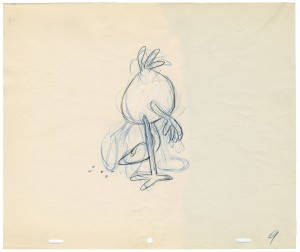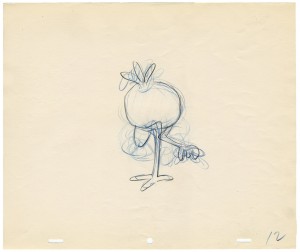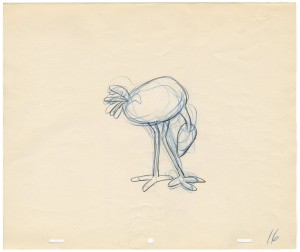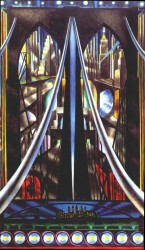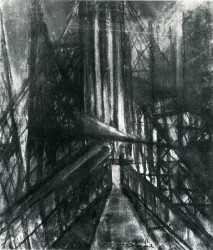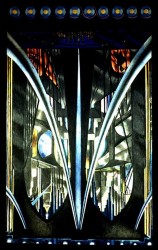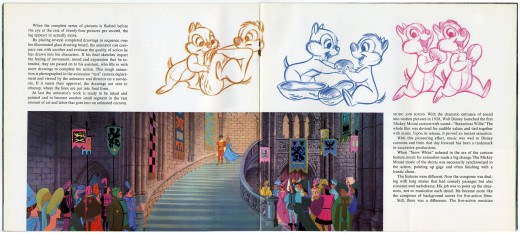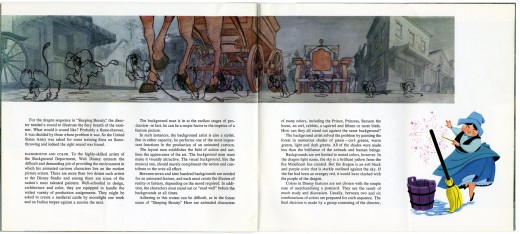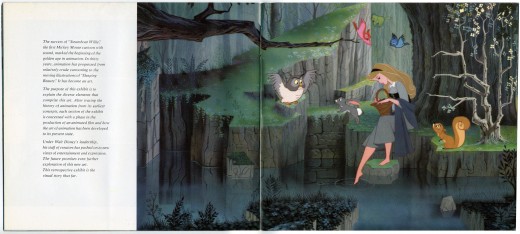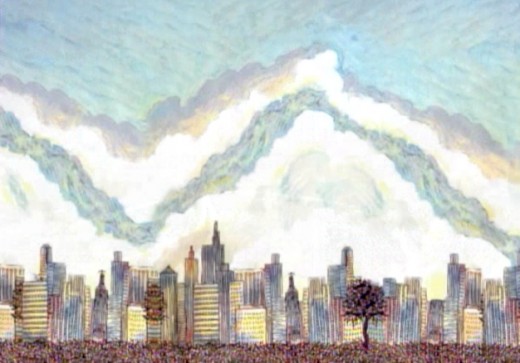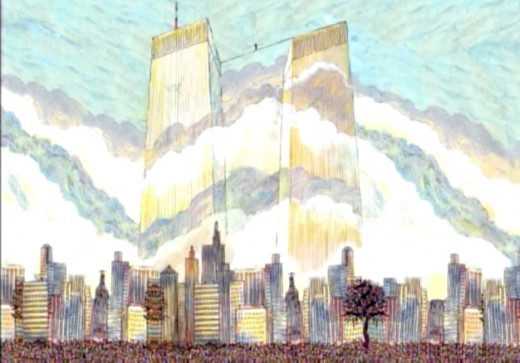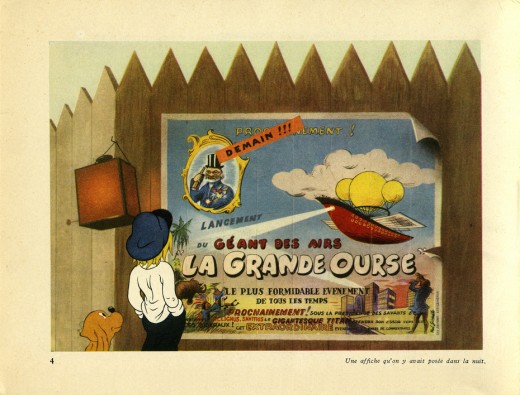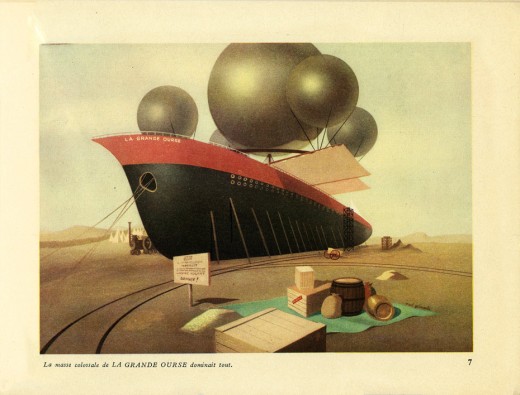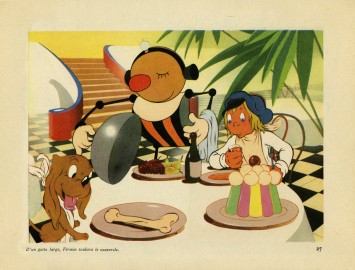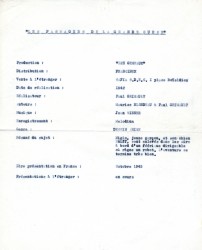Monthly ArchiveSeptember 2006
Comic Art 17 Sep 2006 08:08 am
Masters of American Comics
- As of September 15, a two-part exhibition, presented simultaneousely at The Jewish Museum and The Newark Museum. This is being billed as “the first major museum examination of one of America’s most popular art forms.”
Hundreds of originals created by some of America’s most influential comics artists will be on display.
The Newark Museum will show comic strips from the first half of the 20th century through the work of such artists as Winsor McCay, Chester Gould and Charles M. Schulz. The museum also has a schedule of guest artists including Jules Feiffer, Patrick McDonnell, Jerry Robinson, Pete Hamill, and Steven Guarnaccia who will talk. For schedule.
The Jewish Museum will display comic books from the 1950s onward including Will Eisner, Jack Kirby, R. Crumb, Chris Ware and more.
The Jewish Museum also has the exhibition Superheroes: Good and Evil in American Comics with over 70 works from the golden age of comic books focusing on superheroes and super villains such as Superman, Batman and the Joker.
There are two separate books on sale at each museum.
The Jewish Museum 1109 Fifth Avenue (92nd Street), NY, NY
The Newark Museum 49 Washington Street, Newark, NJ
Daily post 16 Sep 2006 08:38 am
Scumbling some more
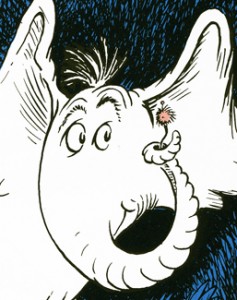 – Cartoon Brew has posted a couple of images from the next feature film from Blue Sky, an adaptation of Horton Hears a Who.
– Cartoon Brew has posted a couple of images from the next feature film from Blue Sky, an adaptation of Horton Hears a Who.
(Images via USA Today and Comingsoon.net.)
I have to admit how pleasantly surprised I am with these stills. The images do look a bit like those old viewmaster slides. This was a problem many of the cgi films had. However, they broke away from that look, and it wasn’t for the better. Everything got pastel-ey with a look of little plastic dolls – see Everybody’s Hero.
It might be a good time to take a look at George Pal’s version of Dr. Seuss, The 500 Hats of Bartholomew Cubbins. This puppet film was nominated for the Oscar in 1944, yet the film seems to be hidden (it’s not on dvd) and stills seem to be a little harder to locate.
The original Horton
I wasn’t quite sure what to expect of a cgi adaptation of Dr. Seuss’ illustration style. Having already adapted two of his books for television, I can relate to the problems inherent. These images are a plus. Let’s hope the script will be strong and the animation will be able to take advantage of the whimsical style of the book. This could be the next decent cgi feature. Undoubtedly, Blue Sky has been doing the second best cgi work out there – behind Pixar, of course. So there’s good reason to have hope. More power to them.
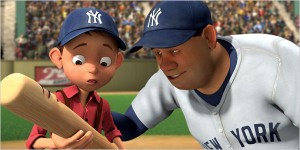 – Speaking of pastel/doll cgi features, Everyone’s Hero quietly moved into theaters yesterday. A review without anything positive to say appeared in the NYTimes; a *** positive one appeared in the NYDaily News and a ** mixed review appeared in Newsday.
– Speaking of pastel/doll cgi features, Everyone’s Hero quietly moved into theaters yesterday. A review without anything positive to say appeared in the NYTimes; a *** positive one appeared in the NYDaily News and a ** mixed review appeared in Newsday.
The Christopher Reeve connection is an interesting one, and I’d like to know more about it. I understand that he lived through much of the storyboarding process, but I wonder how much more involved he was.
Animation &Daily post 15 Sep 2006 08:50 am
Bruno
– On Tuesday evening ASIFA-East will be celebrating the work of Bruno Bozzetto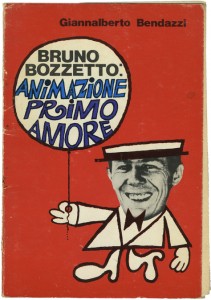 , Italy’s Master of Animation, with the screening of his film, Allegro Non Troppo, the animated parody of Fantasia.
, Italy’s Master of Animation, with the screening of his film, Allegro Non Troppo, the animated parody of Fantasia.
I’ll be hosting a Q&A afterward, and we hope there’ll be a good turnout for this film.
Mr. Bozzetto is on his way to Ottawa as a judge. They’ll also be hosting a more extensive retrospective of his enormous output. Any of you heading to Ottawa should attend as many of these screenings as you can. His work is brilliant.
The ASIFA-East screening will be held at: The School of Visual Arts, 209 East 23rd Street, 3rd floor amphitheatre on Tues, Sept. 19. Admission is FREE.
(pictured: The cover to a small booklet I own written in 1972 by Giannalberto Bendazzi, entitled: Bruno Bozzetto, Animation as a First Love.
Go to the Bruno Bozzetto website and explore the flash films. They’re great.
Animation Artifacts &Hubley 14 Sep 2006 08:00 am
Moonbird
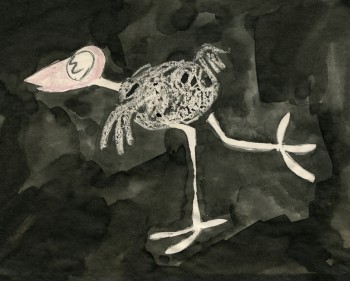 – Moonbird is one of the seminal films of 20th Century animation.
– Moonbird is one of the seminal films of 20th Century animation.
After John Hubley left UPA, where he helped explore the use of 20th Century graphics in animation, he formed a commercial animation company in Los Angeles. Apparently, with this new entity, John did less drawing and more producing. Trying to correct this problem, he closed the LA office and set up in NYC with Faith.
The studio in New York did commercials on a smaller scale. With a Guggenheim Fellowship of $8000, the couple produced a short film, Adventures of an * in 1957 and committed to doing one film a year for themselves. With this film, Hubley picked up where he’d left off at UPA. Exploration of modern art now took on the wildly successful Abstract Expressionists and told a non-verbal story using expressionist art.
The film Tender Game, done in 1958, told another non-verbal story using the song “Tenderly” to illustrate a romance, again, in expressionist art. This film, in some ways, feels like an outgrowth of Hubley’s work on the feature, Finian’s Rainbow.
In 1959, Moonbird took a giant leap forward. The art style borrowed from the expressionists, but used a method of double exposures to layer the characters into the backgrounds. Each animation drawing was painted black outside the border of its lines. Moonbird, the character, was colored with clear wax crayon and painted with black ink. The black resisted where the wax stood and gave a loose scribbled coloring. All of these painted drawings were photographed as double exposures, shot at less than 100%, to combine characters with Bgs.
The soundtrack involved an improvised track of two children, Mark and Ray Hubley, playing. These were recorded in sessions within a recording studio and massively edited down to create the final tracks.
Bobe Cannon animated the film with Ed Smith assisting. Ed inbetweened Bobe’s scenes and animated many others.
A variation of this became the Hubley method. There was usually someone working in the studio who did all inbetweens and animated some lesser scenes. A great way to break into the medium in a big way.
Some extremes by Bobe Cannon are posted below.
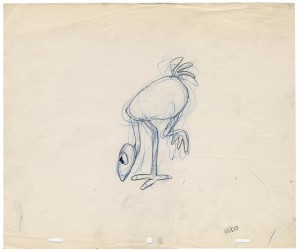
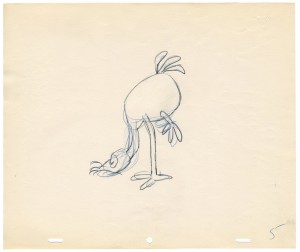
(Click on any image to enlarge.)
Amid Amidi has posted a link to a YouTube version of the film. It looks good.
Daily post 13 Sep 2006 07:29 am
Brooklyn bridges
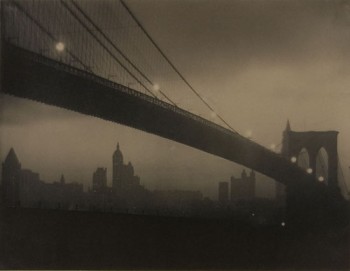 – At first I noticed the number of images of the Brooklyn Bridge that appeared in the work of some artists that I respected enormously:
– At first I noticed the number of images of the Brooklyn Bridge that appeared in the work of some artists that I respected enormously:
Georgia O’Keefe, Joseph Stella, John Marin, and Albert Gleizes among others.
It tooktime for me to realize that this was part of a competition held to honor the bridge, and the images that were created as a result were extraordinary.
Nocturne 1913 – a photo by the extraordinary Karl Struss)
I have always been fascinated with the futurist artists, and, as a result, was attracted to Joseph Stella‘s work. He, among other artists, is most closely associated with the Brooklyn Bridge. There are quite a few paintings and drawings and preparatory sketches he’d created of the bridge. They dominate the one book on his work & life that I own.
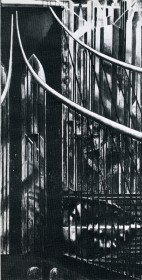 In fact there is one interesting bit of writing he’d done to describe the experience of painting right on the bridge. The piece is, itself, almost futurist:
In fact there is one interesting bit of writing he’d done to describe the experience of painting right on the bridge. The piece is, itself, almost futurist:
To realize this towering imperative vision in all its integral possibilities [he wrote] I lived days of anxiety, torture, and delight alike, trembling all over with emotion as those railing[s] in the midst of the bridge vibrating at the continuous passage of the trains. I appealed for help to the soaring verse of Walt Whitman and to the fiery Poe’s plasticity. Upon the swarming darkness of the night, I rung all the bells of alarm with the blaze of electricity scattered in lightnings down the oblique cables, the dynamic pillars of my composition, and to render more pungent the mystery of the metallic apparition, through the green and red glare of the signals I excavated here and there caves as subterranean passages to infernal recesses.
A bit emotional, perhaps, but he tries desperately to describe his emotions which are articulated so well in the paintings.
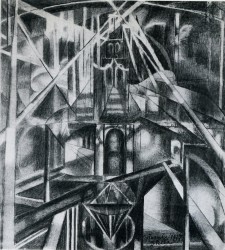
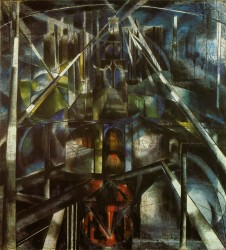
(Click on any image to enlarge.)
Animation Artifacts 12 Sep 2006 08:49 am
Handouts
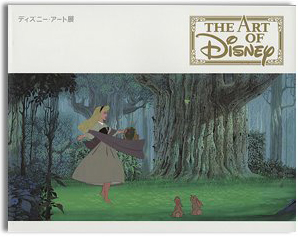 – Recently there’s been some attention given to an exhibition catalog from the Museum of Contemporary Art in Tokyo, The Art of Disney. This catalog is a sizeable 242 pages and has been featured on a number of sites: Cartoon Brew, Mark Kennedy. It appears to have a number of pages taken from the 1958 Bob Thomas book, The Art of Animation.
– Recently there’s been some attention given to an exhibition catalog from the Museum of Contemporary Art in Tokyo, The Art of Disney. This catalog is a sizeable 242 pages and has been featured on a number of sites: Cartoon Brew, Mark Kennedy. It appears to have a number of pages taken from the 1958 Bob Thomas book, The Art of Animation.
Back in the good old days of the late 60′s – early 70′s, in New York, there were a number of appearances in which a group of Disney animation people would talk about the art. At Lincoln Center (discussed in a separate posting) Frank Thomas, Ollie Johnston, Woolie Reitherman, Ken Anderson appeared. At MOMA to honor The Jungle Book, Gilda Radner introduced Eric Larsen and Ken Anderson. At SVA, John Lahr introduced Milt Kahl. There were others. To accompany these talks, there were often handouts.
At Lincoln Center, they gave us copies of a slick, stapled brochure sized truncation of the Bob Thomas book, The Art of Animation. His name as nowhere to be found on that booklet, but the stills and layout was the same as his tome. As a matter of fact, no names could be found in that booklet. Interestingly, that’s where they began selling the Christopher Finch book, The Art of Walt Disney.
It was nice to get something for free, though. It was colorful and attractive. Since I’d memorized the Thomas book, for some reason, I felt no need really to even look carefully through this item.
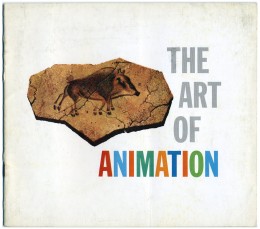
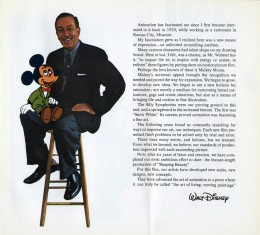
(Click on any image to enlarge.)
Animation Artifacts 10 Sep 2006 09:03 am
La Grande Ourse
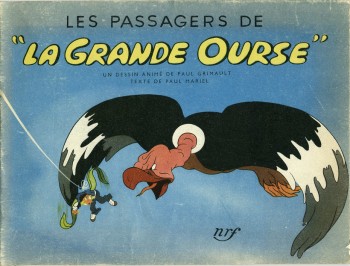 – In 1942 Paul Grimault released an animated film entitled Les Passagers De “La Grande Ourse.” The film had actually been completed in 1939 and titled Gô in the Birds, but because of the outbreak of WWII the film suffered setbacks and was released in 1942 with the new title.
– In 1942 Paul Grimault released an animated film entitled Les Passagers De “La Grande Ourse.” The film had actually been completed in 1939 and titled Gô in the Birds, but because of the outbreak of WWII the film suffered setbacks and was released in 1942 with the new title.
Several years ago, John Canemaker gave me a gem of an attractive little book that was illustrated with images from the film. Grimault was the father of French animation, and I’d always assumed that this film was a feature. In fact, it was a nine min. short, but it was important historically because it was the first big French animated production trying to out-Disney Disney.
The story is very unlike American films. There’s a fanciful sense of imagination that is true of many French cartoons. In summation the story is:
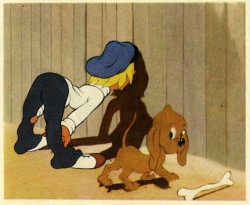 A little boy and his dog sneak into a shipyard and are grabbed by a crane which places them on a ship in dock, loading. This ship, “The Grand Ourse,†is an oddity in that it is fitted like a zeppelin with balloons to lift it into the air.
A little boy and his dog sneak into a shipyard and are grabbed by a crane which places them on a ship in dock, loading. This ship, “The Grand Ourse,†is an oddity in that it is fitted like a zeppelin with balloons to lift it into the air.
Boy and dog arrive in their compartment, accidentally, as the vessel starts to take-off into the sky. Adventures ensue with the boy and dog confronted by a restive eagle and a deaf and dumb robot
Here are some of the pages of the book:
A carbon copy of the credits for the film was enclosed within the book when I received it.
It was copied onto one of those pieces of paper that could only be European, sort of a tissue that seemed delicate.
That’s attached to the left.
(Like all images on the page, just click any of them to enlarge to a legible size.)
Commentary &Daily post 09 Sep 2006 08:37 am
New Yorker II
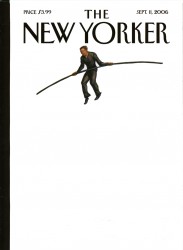 – I’m pleased that John Mavroudis (who, with Owen Smith, created the New Yorker‘s 9/11 cover) left a comment on my site detailing the development of his image. I’m also pleased that he didn’t seem offended that I questioned his originality in the creation. It’s obvious from his work that the idea was his, and I was wrong to have challenged him.
– I’m pleased that John Mavroudis (who, with Owen Smith, created the New Yorker‘s 9/11 cover) left a comment on my site detailing the development of his image. I’m also pleased that he didn’t seem offended that I questioned his originality in the creation. It’s obvious from his work that the idea was his, and I was wrong to have challenged him.
Mr. Mavroudis also left information about his site which goes into the development process in greater depth and offers other variations on the theme. It gives a good presentation of what goes into one of the magazine’s covers.
Also, take a look around at his other illustrations; he’s a fine artist with a lot of excellent work on display at the site.
- Speaking of originals, Michael Barrier reviews Monster House and A Scanner Darkly. He always has astute, intelligent and interesting things to say, and his review of these two films is no exception. Conjoining these two films in the one review is particularly apt since one was “scanned” via some rotoscoping/computer technique and the other used a motion-capture/computer technique.
- AWN has a good interview with NY Independent, Patrick Smith. Worth a look.
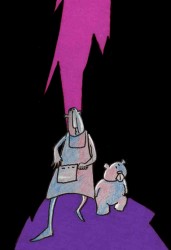 By the way, isn’t AWN able to put these articles on one page so we don’t have to keep clicking forward? This is something that many papers like doing, and I’ve never quite understood it. At least, with the NYTimes you can request have it all on a single page. The only way to do that with AWN is to click on the printable version, but that is missing any illustrations. (Just a pet peeve. Sorry I bothered you with it.)
By the way, isn’t AWN able to put these articles on one page so we don’t have to keep clicking forward? This is something that many papers like doing, and I’ve never quite understood it. At least, with the NYTimes you can request have it all on a single page. The only way to do that with AWN is to click on the printable version, but that is missing any illustrations. (Just a pet peeve. Sorry I bothered you with it.)
- I’ve just been asked to be involved in a retrospective of my work at the Seattle Children’s Film Festival. A nice way to start the day. Of course, I’ve said yes. At the moment, I can’t believe the Ottawa Festival is bearing down on me. My schedule is getting intense, and all my attention is really only with my Claude cat at home.
(The images enlarge when you click them.)
Daily post 08 Sep 2006 07:31 am
Scumbling
- I was sad to learn that Jan Svochak passed away yesterday at the age of 80. He was a gifted animator. There’s a nice notice on Cartoon Brew written by J.J.Sedelmaier. Most people initially connect him with the Hawaiian Punch commercials he animated, but I immediately think of the Electric Company spot he did for John Hubley: Milt’s Guilt.
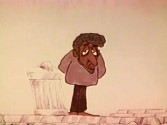
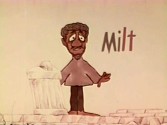
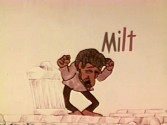
“I’m Milt, and I’m filled with guilt.”
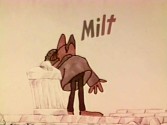
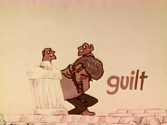
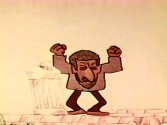
I’m Milt, and I’m filled with guilt.” . . . I’m Milt, and I’m filled with guilt.”
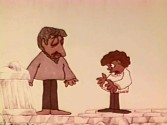
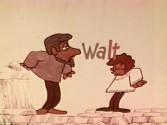
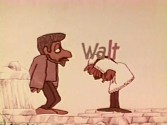
I’m Walt, and it’s not your fault.” . . . I’m Walt, and it’s not your fault.”
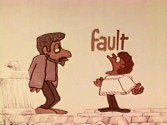
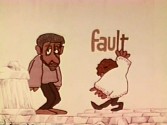
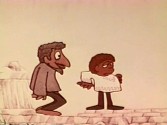
. . . I’m Walt, and it is not your fault.
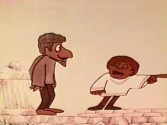
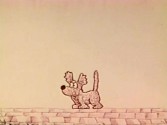
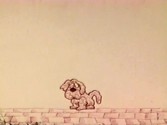
. . . It’s his fault.” (Pan image to innocent looking puppy.)
- Charles Solomon discusses some of the Oskar Fischinger films on NPR. This can be viewed (and heard) here. There are also a couple of excerpts from the films Allegretto, an excerpt from Fantasia and Spiritual Constructions. The silent film, Spiritual Constructions, uses the Liquid Liquid tune, Cavern, as background music. This is an interesting choice. I once did a music video to this tune way back in 1983. Richard McGuire, a member of Liquid Liquid is now co-directing Fears of the Dark, an animated feature in France.
- Jim Hill Media posts some “concept art” for Meet The Robinsons. It looks like another pastel-colored cgi film using a little-doll “concept” for the characters that bend and shape oddly. Maybe the script is good.
- For some real concept art, turn once again to the ASIFA-Hollywood Animation Archive. Stephen Worth has another gem of a posting – this site shows up almost daily with some new treasure!
Some beautiful model sheets from Pinocchio and Hiawatha have been posted. These are the work of Albert Hurter and Charles Thorson.
- By the way, this site also led me to a book, Cartoon Charlie: The Life and Art of Animation Pioneer Charles Thorson by author, Gene Walz. I hadn’t heard about this and will certainly try to get a look. Thorson was responsible for a number of Disney model sheets as well as some early WB models of Bugs Bunny and Elmer Fudd.
There’s a critical look at the book and an extended version of Thorson’s bio on Take One, the film journal. There’s also a review of the book on AWN by Fred Patten. The book, of course, is available on Amazon.
- Didier Ghez‘ site, Disney History, also has some great info by Jim Korkis about the uncredited backup singing by the Hall Johnson Choir in Song of the South and Dumbo.

